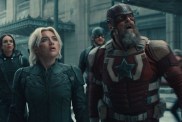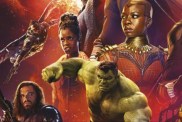If Anything Happens I Love You deservedly walked away with the Academy Award for Best Animated Short Film last month thanks to its relevant themes and carefully constructed narrative. ComingSoon.net got the opportunity to chat with the film’s editor, Peter Ettinger, who discussed the unique challenges presented by such a powerful film.
Ettinger has served as editor on films such as Lithium, Dangerous Cargo, and the animated film Smallfoot. He also worked as assistant editor on The Horse Whisperer, The Fast and the Furious, and The Bourne Identity, among many others; and directed the short film The Phoenix, Lonely Street with Jay Mohr and Robert Patrick, and the TV series Animal Exploration with Jarod Miller.
Check out ComingSoon’s full Peter Ettinger interview about If Anything Happens I Love You below, and be sure to check out the animated film, available now on Netflix.
Jeff Ames: Have you come down from the high cloud you were on after winning the Best Animated Film Oscar?
Peter Ettinger: [Laughs] It’s surreal in a way. Yeah. It comes in waves. You know, based on where this had started and where it ended up, it’s just an amazing ride.
Ames: What drew you to If Anything Happens I Love You?
Ettinger: So, the producer, Maryann Garger, who I’ve known for a number of years, she asked me what I was doing, if I was interested in cutting a short … and just because it was her, I said, “Yes,” kind of sight unseen. She introduced me to the director Michael Govier and Will McCormack, and they showed me some of the artwork and an animatic they put together, and immediately the emotion and the grief that these parents were going through really hit me on a deep level, and the passion for the project, that Will and Michael had, and their vision for it was really what drew me to it.

How important is a film like this for audiences to see?
I think is incredibly important. We made this prior to COVID. So, even before COVID, there was a need for that cathartic release, or, you know, to be able to know that you’re not alone if you’re going through grief. No matter the subject matter. And then, of course, COVID hit, and I think it became so real for so many people on so many different levels that it became extremely timely in a way that none of us could have ever imagined. I’ve had a lot of people reach out to me, who have identified with it and had such an emotional reaction to it. Even beyond a gun violence situation, you know, the loss of a child in a different way, or loss of parents. We as humans, we’re faced with loss. It’s inevitable, and it’s how we deal with it, and how we can grow from it and how we can have empathy for others who are going through it. I think that’s all important.
How do you tackle a film with such a heavy narrative? Is it business as usual, or do you find yourself altering your style slightly?
This one was very much not business as usual. It always had that special feeling to it and it had a little bit of reverence about it. Because I wanted to — everybody wanted to — treat it with respect. And so, as you go through the mechanics of putting it together, I’m constantly putting myself in the audience’s shoes to make sure that every moment feels authentic, and it’s not being gratuitous, which I think was important. Clearly, Will and Michael had an eye on that. It was never meant to be exploitive. It was a meditation on grief. That was their mantra for it. As I was going through it and assembling it, you know, you want to bring some filmmaking tools to it. And so, okay, what can I do to make — through editing —audiences feel slightly uncomfortable? And so, early on, I would cut away a little bit earlier than might have been normally satisfying in a normal scene. So, the cumulative effect becomes, “Oh, there’s something uneasy about this and I feel a little bit off.” But then later, when there are scenes of better days, I linger on shots a little bit longer so you can have that sense of satisfaction. The connection between the characters has a warmer feel to it in those memories, which I think is important. So, it was an interesting challenge to bring an editorial sense to this story. Without feeling like we’re pulling strings or pushing buttons overtly.
That’s amazing. How does one go about learning those editing techniques? Is it something that you learned over the course of your career? Is it something that’s taught specifically — like, you do it this way, or that way? Or is it something you just have to learn through trial and error?
You can’t see me but I’m shaking my head, because I think there’s a magic and a mystery to editing, even being deep in it, and it’s all about emotion. And to sit down and try to describe the process, or every thousands of decisions that go through my head at any moment is, I think, is nearly impossible. I think it’s instinct. You have to feel what the material wants to be and what it’s telling you that it wants. And so, it’s a constant back and forth of pulling my hair out. Is this the right choice? Does it work? Does it not work? I know it’s a little bit vague of an answer, but I think there are standard things that all editors do. You think about, “Okay, how long can I hold on a shot without it becoming too boring?” Or you want to create momentum in how quickly you cut from shot to shot, which can evoke a mood. But it all has to serve the material and what’s right for that moment. So that’s really what my approach was. And it was the first time that I’ve approached the material in that way. “Oh, let me try to shortchange shots a little bit here and there.” And, I don’t know, hopefully, it’s subtle enough that you don’t notice it. But it’s like I said, it does have that cumulative effect. Especially editing in animation, where editing is the core because everything has to come and go in editing and out of editing. So, in live-action, you edit the movie that’s been shot. With animation, you shoot the movie that’s going to edit it. So, we start off with storyboard panels and get a timing down and then that’s what gets turned over to the animator, and they start to deliver shots back. So, it’s a constant back and forth.
That’s so interesting. So, what would you say is the biggest difference in your approach to editing a film like Smallfoot, which you worked on, and a live-action film, like The Bourne Identity, where you served as first assistant editor?
Ettinger: With live-action, you’re on a movie that’s probably going to be fairly specific to a genre. Whether it be comedy or thriller, there are going to be conventions within those genres that you’re going to want to adhere to. In animation, you have a number of genres all within one. So, you’ve got the action, chase sequences, you have the romance, you’ve got the comedy — all different types of comedy — you’ve got slapstick comedy, you’ve got jokes in dialogue, you have to try and set up and pay off visual gags … So, that’s what I love about being an animation editor, you need to delve into a lot of different genres and experiment with what can turn those conventions on their head too so it doesn’t become, “Oh, they’re just ripping off the heist from Ocean’s 11,” or whatever. You start with the familiar, and because it’s animation, you can go in any direction possible.
With [If Anything Happens I Love You], because it’s such a different tone and mood, it is much more of an emotional piece than any of the big live-action movies I’ve worked on or even the big animated films. I feel like I spent longer on this short than on a bigger feature, just emotionally and in every moment.
Ames: Do you feel limited with what you can do on a short film because of time constraints?
Ettinger: It’s hard with a short because people go into it knowing it’s a short film. So, either the audience expectation ahead of time is, “Okay, I need to be satisfied quicker and sooner, because get to the point.” What I think is successful about [If Anything Happens I Love You], and the way that it was boarded originally, is it does take its time. And so, I was constantly making sure that my foot wasn’t on the gas. Like, “Okay, just let it breathe for a moment.” And then every new piece of information, hopefully, arrives right at that moment either right when you’re expecting it or just before … So, seeing the shirt in the dryer is one of the first bigger clues of the movie where there’s a tone shift. And then the soccer ball falls, and the record player, and that’s what leads the parents to start the conversation to reminisce. And so, I’m hoping that right at that moment, people are feeling like, “Okay, now I know what this is starting to be about.”
Ames: So, the movie ends up taking home the Academy Award for Best Animated Short Film. Did that surprise to you? Or did you know that you had something really special on your hands early on?
Ettinger: So, throughout the process, I showed it to my wife and had shown it to some friends. And every time I hit stop, I’d turn around and there’d be tears rolling down their faces. Just on that level, knowing that this is an emotionally impactful, fresh piece of art, I think we all collectively knew that it was going to be successful in that way. It started getting to some film festivals, started winning some film festivals, and won an Oscar-qualifying film festival. So, as that momentum started to build, I think that began that inkling or that hope of, “Could this little homemade movie, with no money and people doing it for favors, could it actually achieve what it did? And ultimately, I’m happy that it did because it gives it a wider audience, and more people can experience it and spark conversations about grief, about the subject matter in ways that maybe wouldn’t have been if the film hadn’t been seen in such a wide platform.
Ames: Where do you go from here, after being involved with something so powerful?
Ettinger: I just want to continue to do good work. I think every project you build from the one previous. I learned a lot through the process. I’m looking forward to applying what I’ve learned on the next one. You know, I’m going on to another feature with a couple of directors who I’m really looking forward to working with and it’s gonna be back to more of a big, epic, animated film. So, that’s going back to that idea of multiple genres, but there’s going to be a heart at the core of it. So, you know, just continue to make sure that despite what the scene is, make sure that there’s a heart and there’s a connection between the characters and between the characters and the audience. I think that’s the most important thing.
MORE: Michael B. Jordan Supports Black Panther Sequel Moving Forward










